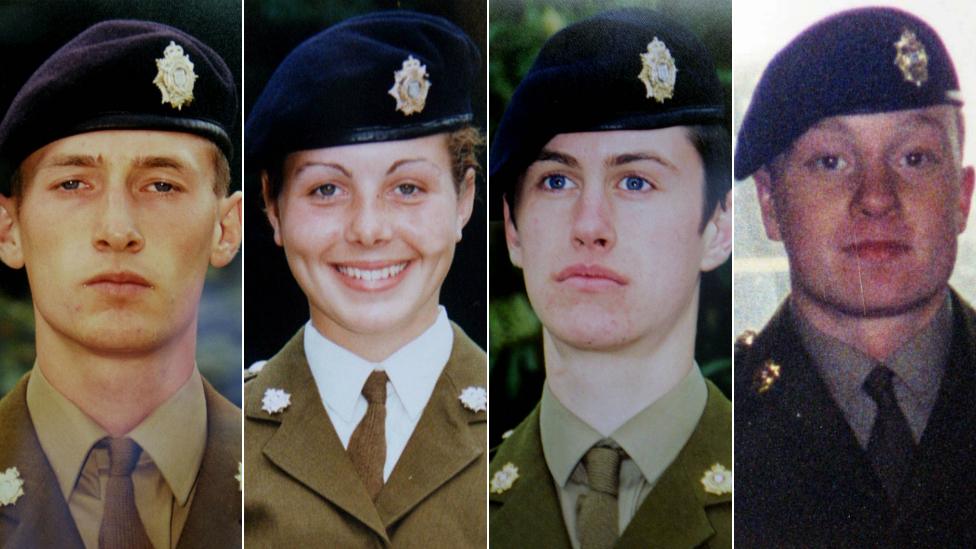Deepcut inquest: Bullet wound 'consistent' with self-inflicted injury
- Published

Pte Cheryl James was found dead with a bullet wound to the head
The bullet wound that killed a teenage soldier was "consistent" with a self-inflicted injury, according to a ballistics expert.
Pte Cheryl James, 18, was found dead at Deepcut barracks in Surrey in 1995.
Former forensic scientist David Pryor said it was his "strong opinion" a bullet injury between her right eye and nose was an "intimate contact shot".
Mr Pryor was asked to provide a report seven years after the death of Pte James, from Llangollen, Denbighshire.
He had worked using photographs of her body, and said he had "vastly less information" than if he had been involved in the case earlier.
He told the inquest in Woking that pictures of Pte James's body showed a "rifle by her side, muzzle pointed towards her head".
"I considered that the position was consistent with her having held the rifle," he said.
'Hands near muzzle'
Mr Pryor said blackening between her thumb and forefinger "could be discharge residue from the weapon" but could also be dirt and dust from the scene.
He said the wound showed features "consistent with a contact shot", and added: "By that I mean with the weapon muzzle in intimate contact with her head."
Forensic ballistics expert Ann Kiernan said black marks on one of Pte James's hands were consistent with her holding the barrel of the rile when it was fired.
She also said her opinion was the muzzle of the weapon was at contact, or near contact, to Pte James's face at the time of discharge.
"The orientation of her body, particularly hands and rifle, are consistent with a self-inflicted incapacitating injury," she said.
Ms Kiernan admitted it was not possible to exclude other possibilities from the evidence.
She also told the inquest it was unusual for there to be no exit wound with a close-range shot, but that it could occur if the bullet broke up inside the skull.

The body of Pte Cheryl James was found near the perimeter fence
Alison Foster QC, representing the family of Pte James, questioned Ms Kiernan about the validity of her tests.
The inquest had heard Ms Kiernan carried out experiments using synthetic bone, skin and tissue and pig skin at various firing distances to simulate the injury and deposition of discharge residues from the rifle.
But Ms Foster described the methods as "haphazard" and added: "The tests devised just couldn't show the failure of the exit wound or fragmentation of the bone within the head space."
Ms Kiernan, who has more than 15 years experience, denied this but admitted she was not able to simulate perfectly a real human head.
She added: "I'm not saying who pulled the trigger, I've never mentioned that."

Pte Cheryl James died in woods near the gate of Deepcut barracks
Ms Foster said: "I have to suggest there are examples in your report that you did come to the case with a preconceived idea...and your initial view was that the shot was self-inflicted, a self-shooting."
She accused the expert of lacking the experience or expertise to carry out the practical tests and added: "Your approach to this hasn't been scientifically or professionally sound."
Pte James was one of four recruits to die at the base in seven years.
An initial inquest into her death in 1995 recorded an open verdict, but that was overturned by the High Court which ordered the new hearing.
The inquest continues.
Who were the Deepcut four? Background to the deaths and timeline of events.

Privates Benton, James, Gray and Collinson died at Deepcut between 1995 and 2002
- Published11 April 2016

- Published23 March 2016

- Published21 March 2016

- Published18 March 2016

- Published20 June 2019
